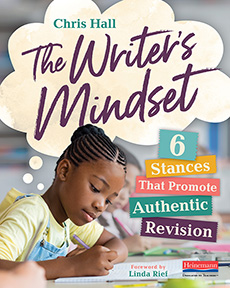6 Stances That Promote True Writing Revision
The Writer’s Mindset: 6 Stances That Promote Authentic Revision
By Chris Hall
(Heinemann, 2022 – Learn more)
Reviewed by Anne Anderson


The author explains how those statements – and others – led him to change his definition of revision. “Revision was about what was happening in the mindset of the writer, during the writing process, not just on the page, after it was done.” (p. 9)
As he began to notice the behaviors his students were displaying in their revision journey, Hall chose to use the term stance. That word, along with his explanation and example, was one of many Aha! moments for me in this book.
The six stances, or behaviors, that emerged are addressed in chapters 2–7: metacognition, optimism, perspective-talking, flexible thinking, transfer, and risk-taking. With each chapter, Hall identifies core beliefs about the behavior and then presents activities for practice and implementation. Included throughout the chapter are a number of examples of student writing and student reflections, along with conversations from the classroom. Everything is useful!
Metacognition: Writers Develop Through Self-Awareness
“One of the biggest ways to help our students is by making them more aware of their thoughts about their writing as they’re drafting…” (p. 19) The graphic below is an example of the internal dialogue – that invisible dialogue – that goes on inside the writer’s head.
Hall shares how he models metacognition for a memoir he is writing. His think-aloud shows the ways writers talk to themselves while writing. He includes three suggestions for selecting a piece to model:
1. If students are somewhat familiar with the piece you are modeling, they can focus on your reflections.
2. This is not a polished piece; it is a work in progress.
3. Your think-aloud should include a variety of reactions (e.g., frustration, excitement, confusion, etc.).
I believe middle school students will enjoy his idea of using Emoji Annotations. This is a quick, visual way for students to reflect metacognitively on their drafts and rates as another Aha! moment.
As students read their draft to themselves, they add emojis to indicate how they are feeling about the topic or about the writing itself, or how they hope their readers might feel. The fact that you can go high-tech or low-tech with this activity makes it a worthwhile addition to your teacher toolbox.
He concludes this chapter with four suggestions for Striking a Balance with Metacognition:
1. Avoid extensive metacognition too early in the writing process (other than perhaps to identify positives).
2. Don’t wait until after “The End.”
3. Strive for a mix of diving in and stepping back.
4. Keep metacognitive activities brief, periodic, and playful.
A book filled with Aha! moments
Chapters 3–7 are similarly arranged: belief, practice (activities), and mini-lessons. In the chapter on Optimism the author reminds teachers to “give lots of prewriting practice.” (p. 47) That affords your students several choices when it comes time to select one to revise. In addition, Hall suggests quickwriting, webbing and listing – and also visual strategies – as opportunities to free us (writers) from our internal critics. He includes a sample Peer Conference Kudos handout that can be used in writing conferences.
Yet another Aha! goes to Hall’s student Courtney for her creation, Poetry Pockets. Courtney made a little paper pouch, similar to a library card pocket, which was attached to each student’s poem. The poems were posted on the bulletin board; throughout the week, students read their classmates’ writings and then left positive notes for each other in the poetry pockets.
While I found the book to be filled with Aha! moments, the author had me nodding on page 86: “Sometimes our conferences can feel like triage.” I have been both the recipient and the giver of those kinds of conferences. Hall reminds us that we have to connect with a student in order to have a meaningful conference. He shares several practices that were successful for him and his students. Throughout the book, Hall reminds us of the impact of face-to-face conferencing!
Hall encourages teachers to examine and shift the language we use with students. The activities included in Chapter 5, Flexible Thinking, promote play with possibilities (e.g., Rolling Revisions, Spin the Revision Wheel, Blackout Poems, or creating Memes).
We are reminded by the author that the mini-lessons to encourage Risk Taking must be supportive. Model and discuss how you, the writer, take risks. As you and your students move forward into this writer’s mindset, you will definitely be taking risks as a teacher. Good news! Chris Hall provides the needed support throughout the pages of The Writer’s Mindset: 6 Stances That Promote Authentic Revision.
I realize pretty is not a normal descriptor for a professional resource, but it works for this book. Cover and Interior Designer Vita Lane selected a warm color palette that evokes feelings of stability and orderliness – a perfect choice for a book that is asking writers to take risks with their writing. Kudos to Heinemann for producing such a pretty book.
A fresh look at classroom practices
The Writer’s Mindset: 6 Stances That Promote Authentic Revision will lead the reader to reexamine classroom practices. Start now! After reading the book, select one stance for your focus. Between now and the end of this school year, add one or more new practices into your writing workshop. With the feedback from your current students, you will have an advantage in 2022-2023!
You might even want to read the epilogue first!
Read author Chris Hall’s article for MiddleWeb!
Anne Anderson always knew she wanted to be a teacher. She graduated from East Texas Baptist University with an English major and History minor and did graduate work at Louisiana State University and Louisiana Tech University. After teaching 8th graders for 24 years, Anne served as a content coach. Since retiring in 2011, Anne has worked as an educational consultant, presenting at national conferences and onsite trainings for public and private schools.
Calendar Celebrations: March, April, May is the third book in Anne Anderson’s series on resources for months of the year. (She wrote about the first one here and the second one here.) Anne has also published articles in IDEAS Plus and Voices from the Middle, publications of the National Council of Teachers of English. She is a frequent reviewer of professional books for MiddleWeb.com.



































